| Daihatsu Boon | |
|---|---|
 Second-generation Daihatsu Boon (M600, Japan) | |
| Overview | |
| Manufacturer | Daihatsu |
| Also called |
|
| Production | June 2004 – present |
| Assembly | Japan: Ikeda, Osaka (Ikeda plant) |
| Body and chassis | |
| Class | Subcompact car |
| Body style | 5-door hatchback |
| Layout | |
| Chronology | |
| Predecessor | Daihatsu Storia |
The Daihatsu Boon (Japanese: ダイハツ・ブーン, Hepburn: Daihatsu Būn) is a subcompact car produced by Japanese automaker Daihatsu since 2004, and also sold under Toyota brand as the Toyota Passo (Japanese: トヨタ・パッソ, Hepburn: Toyota Passo) between 2004 and 2023. The Passo was once sold at Toyota Corolla Store Japanese dealerships until it was consolidated with other Toyota dealers in 2020.
Outside Japan, the first- and second-generation Boon is sold as the second- and third-generation Sirion. The first-generation Sirion was sold as the Storia in Japan.
According to Daihatsu, the name "Boon" is derived from the English word boon, and also inspired by the sound that Japanese children make when imitating the sound of a car,[1] while the name "Passo" is Italian for "step". According to Toyota, the name conjures up the image of a casual and approachable car.[2]
First generation (M300/AC10; 2004)
| First generation (M300/AC10) | |
|---|---|
 Pre-facelift Sirion (Germany) | |
| Overview | |
| Also called |
|
| Production |
|
| Designer | Aiji Shimizu, Kazuki Tanaka, Michio Tada, Takumi Ichikawa and Toku Harumino (facelift)[3] |
| Body and chassis | |
| Related | Daihatsu Coo/Materia / Toyota bB / Subaru Dex |
| Powertrain | |
| Engine | |
| Power output |
|
| Transmission | |
| Dimensions | |
| Wheelbase | 2,440 mm (96.1 in) |
| Length | 3,600–3,630 mm (141.7–142.9 in) |
| Width | 1,665 mm (65.6 in) |
| Height | 1,535–1,550 mm (60.4–61.0 in) |
| Curb weight | 900–980 kg (1,984–2,161 lb) |
The development for the first-generation Boon was led by Toyota chief engineer Tetsuya Tada.[4] For the Japanese domestic market, the Boon were available with 996 cc and 1.3-litre engines. The major difference between the Japanese Boon and Sirion are automatic version where the gear-changing located beside the steering on the dashboard and the handbrake below the steering. Both the Japanese Boon and European Sirion were offered in both front-wheel drive and four-wheel drive versions. A 936 cc turbocharged version with four-wheel drive was also available, known as the Boon X4.
The Boon was designed for European tastes and the model took on a larger and stockier frame. It weighs about 940 kg (2,072 lb). With the back seats down, its luggage capacity increases from 225 L (8 cu ft) to 630 L (22 cu ft).
In early 2005, Daihatsu launched the Japanese-built 2nd generation Sirion in Brunei using the facility and parts from the Boon. The model was discontinued in 2010 before Daihatsu exited the Brunei market as the passenger cars market (except the commercial vehicles) in 2014 and the Sirion is replaced by the Perodua-badged Myvi, which is launched in the country since April 2016.
On 25 May 2005, Malaysian automaker Perodua launched a variant of the Boon known as the Perodua Myvi. Sporting a few cosmetic differences, the Myvi became Perodua's best-selling car in Malaysia for 2006, 2007, 2008 and 2009.
On 25 December 2006, the Boon was restyled. This version was exported to Europe as the Sirion in 2007.
In 2007, Daihatsu launched the Sirion in Indonesia using the facility and parts from the Myvi.[5]
The Subaru Justy was unveiled at the 2007 Frankfurt Motor Show using the Boon model. It is positioned as an entry-level model in Subaru's lineup.
In April 2013, Toyota New Zealand announced its decision to stop selling the second-generation Sirion, still on sale, stating it was unable to secure Daihatsu products that comply with future regulatory standards for New Zealand.
The second-generation Sirion was discontinued in South Africa in April 2015, when Daihatsu left the South African market.
- Boon/Sirion
 Facelift Sirion (Germany)
Facelift Sirion (Germany)_%E2%80%93_Heckansicht%252C_9._Juni_2011%252C_W%C3%BClfrath.jpg.webp) Facelift Sirion (Germany)
Facelift Sirion (Germany)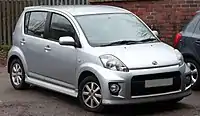 Facelift Sirion SX (UK)
Facelift Sirion SX (UK) Boon X4 (M312S, Japan)
Boon X4 (M312S, Japan)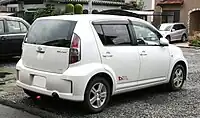 Boon X4 (M312S, Japan)
Boon X4 (M312S, Japan) Boon at the 2006 Rally Japan
Boon at the 2006 Rally Japan
- Passo
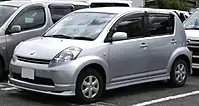 2004–2006 Toyota Passo (Japan)
2004–2006 Toyota Passo (Japan) 2004–2006 Passo (Japan)
2004–2006 Passo (Japan) 2006–2010 Passo (Japan)
2006–2010 Passo (Japan)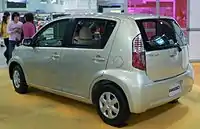 2006–2010 Passo (Japan)
2006–2010 Passo (Japan)
- Justy
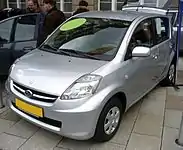 Subaru Justy
Subaru Justy
Boon Luminas (M500; 2008)
| Daihatsu Boon Luminas (M500) | |
|---|---|
_front.jpg.webp) Boon Luminas CX Aero (M502G, Japan) | |
| Overview | |
| Also called |
|
| Production | December 2008 – March 2012 |
| Assembly | Japan: Ōyamazaki, Kyoto Malaysia: Rawang, Selangor (PMSB, Perodua Alza) |
| Designer | Kenyuu Uehata, Masanori Hashimoto and Nobuhiro Hata[6][7] |
| Body and chassis | |
| Class | Mini MPV |
| Body style | 5-door wagon |
| Powertrain | |
| Engine |
|
| Power output | 80 kW (107 hp; 109 PS) |
| Transmission | 4-speed automatic |
| Dimensions | |
| Wheelbase | 2,750 mm (108.3 in) |
| Length | 4,180–4,195 mm (164.6–165.2 in) |
| Width | 1,695 mm (66.7 in) |
| Height | 1,620 mm (63.8 in) |
| Kerb weight | 1,170–1,240 kg (2,579–2,734 lb) |
| Chronology | |
| Predecessor | Toyota Corolla Spacio (E120) (Passo Sette) |
On 25 December 2008, Daihatsu and Toyota launched the seven-seat MPV under the Boon and Passo nameplates called the Boon Luminas (Japanese: ダイハツ・ブーン ルミナス, Hepburn: Daihatsu Būn Ruminasu) and Passo Sette (Japanese: トヨタ・パッソ セッテ, Hepburn: Toyota Passo Sette) in Japan.[8] "Sette" means "seven" in Italian, referring to the car's 7-seater capability. The Boon Luminas and Passo Sette were discontinued in early 2012 due to poor sales. The Malaysian variant was launched in the country as the Perodua Alza on 23 November 2009, and fared much better there.
- Boon Luminas
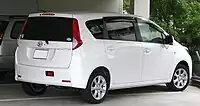 Boon Luminas (M502G, Japan)
Boon Luminas (M502G, Japan)_rear.jpg.webp) Boon Luminas CX Aero (M502G, Japan)
Boon Luminas CX Aero (M502G, Japan)
- Passo Sette
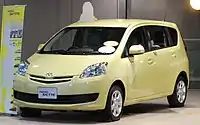 Passo Sette G (M502E, Japan)
Passo Sette G (M502E, Japan) Passo Sette G (M502E, Japan)
Passo Sette G (M502E, Japan)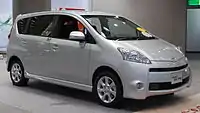 Passo Sette S (M502E, Japan)
Passo Sette S (M502E, Japan)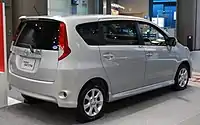 Passo Sette S (M502E, Japan)
Passo Sette S (M502E, Japan) Passo Sette interior (Japan)
Passo Sette interior (Japan)
Second generation (M600/AC30; 2010)
| Second generation (M600/AC30) | |
|---|---|
_front.JPG.webp) Boon 1.0 CL (M600S, Japan) | |
| Overview | |
| Also called |
|
| Production |
|
| Designer | |
| Powertrain | |
| Engine |
|
| Power output |
|
| Transmission |
|
| Dimensions | |
| Wheelbase | 2,440 mm (96.1 in) |
| Length | 3,640–3,650 mm (143.3–143.7 in) |
| Width | 1,665 mm (65.6 in) |
| Height | 1,535 mm (60.4 in) |
| Kerb weight | 910–970 kg (2,006–2,138 lb) |
The second-generation Boon was unveiled in Japan on 15 February 2010 alongside the second-generation Passo.
The second-generation Myvi, based on the Boon, was released in Malaysia on 17 June 2011.[12]
The third-generation Sirion for the Indonesian market was unveiled at the 19th Indonesia International Motor Show on 23 July 2011.[13]
- Boon
 2010–2014 Boon (Japan)
2010–2014 Boon (Japan)
- Passo
.jpg.webp) 2010–2014 Passo (Hong Kong)
2010–2014 Passo (Hong Kong).jpg.webp) 2010–2014 Passo (Hong Kong)
2010–2014 Passo (Hong Kong)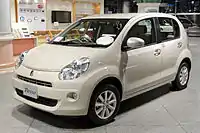 2010–2014 Passo +Hana (Japan)
2010–2014 Passo +Hana (Japan)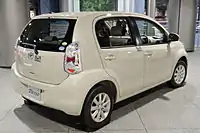 2010–2014 Passo +Hana (Japan)
2010–2014 Passo +Hana (Japan)_front.JPG.webp) 2014–2016 Passo (Japan)
2014–2016 Passo (Japan)_rear.JPG.webp) 2014–2016 Passo (Japan)
2014–2016 Passo (Japan)_front.JPG.webp) 2014–2016 Passo 1.0 +Hana (KGC30, Japan)
2014–2016 Passo 1.0 +Hana (KGC30, Japan)_rear.JPG.webp) 2014–2016 Passo 1.0 +Hana (KGC30, Japan)
2014–2016 Passo 1.0 +Hana (KGC30, Japan)
Third generation (M700; 2016)
| Third generation (M700) | |
|---|---|
_front.JPG.webp) 2016–2018 Boon X L Package SA II (M700S, Japan) | |
| Overview | |
| Also called | Toyota Passo |
| Production | April 2016 – present (Daihatsu Boon) April 2016 – September 2023 (Toyota Passo) |
| Body and chassis | |
| Related | Daihatsu Thor |
| Powertrain | |
| Engine |
|
| Power output | 51 kW (68 hp; 69 PS) |
| Transmission | CVT |
| Dimensions | |
| Wheelbase | 2,490 mm (98.0 in) |
| Length | 3,650–3,680 mm (143.7–144.9 in) |
| Width | 1,665 mm (65.6 in) |
| Height | 1,525 mm (60.0 in) |
| Kerb weight |
|
The third-generation Boon and Passo were unveiled in Japan on 12 April 2016. Both received the first update on 10 October 2018, along with the introduction of "Style" variant for the Boon. The Passo has an improved collision avoidance support system (Smart Assist III) which can grasp various information such as pedestrians, vehicles, preceding and oncoming vehicles, and obstacles and then activate various driver assistance systems such as alerting the driver or switching between low and high beams.[14]
The third-generation Boon is the only model that does not share any mechanical/visual components with the third-generation Myvi/fourth-generation Sirion.
- Boon
_rear.JPG.webp) 2016–2018 Boon X "L Package SA II" (M700S, Japan)
2016–2018 Boon X "L Package SA II" (M700S, Japan)_front.jpg.webp) 2016–2018 Boon Cilq "G Package SA II" (M700S, Japan)
2016–2018 Boon Cilq "G Package SA II" (M700S, Japan)_rear.jpg.webp) 2016–2018 Boon Cilq "G Package SA II" (M700S, Japan)
2016–2018 Boon Cilq "G Package SA II" (M700S, Japan).jpg.webp) 2018 Boon X "SA III" (M700S, Japan)
2018 Boon X "SA III" (M700S, Japan) 2018 Boon Cilq "G Package SA II" (M700S, Japan)
2018 Boon Cilq "G Package SA II" (M700S, Japan) 2018 Boon Style "SA III" (M700S, Japan)
2018 Boon Style "SA III" (M700S, Japan)_rear.jpg.webp) 2018 Boon Style "SA III" (M700S, Japan)
2018 Boon Style "SA III" (M700S, Japan)
- Passo
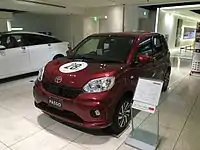 2016–2018 Passo X "G Package" (M700A, Japan)
2016–2018 Passo X "G Package" (M700A, Japan)_front_(cropped).jpg.webp) 2016–2018 Passo Moda "G Package" (M700A, Japan)
2016–2018 Passo Moda "G Package" (M700A, Japan)_rear.jpg.webp) 2016–2018 Passo Moda "G Package" (M700A, Japan)
2016–2018 Passo Moda "G Package" (M700A, Japan))_front.jpg.webp) 2018 Passo X "L Package S" (M700A, Japan)
2018 Passo X "L Package S" (M700A, Japan))_front.jpg.webp) 2018 Passo Moda "G Package" (M700A, Japan)
2018 Passo Moda "G Package" (M700A, Japan))_interior.jpg.webp) Passo Moda interior (Japan)
Passo Moda interior (Japan)
References
- ↑ "Data Book 2020" (PDF). Daihatsu. Archived from the original (PDF) on 22 February 2021. Retrieved 13 August 2020.
- ↑ "Data: Origin of a car's name". Toyota. 2012. Retrieved 14 April 2020.
- ↑ "A00200604253". DGIP.go.id. Pangkalan Data Kekayaan Intelektual. 23 January 2007. Retrieved 10 June 2022.
- ↑ "Tetsuya Tada: Meet the hero behind the Toyota Supra".
- ↑ Daihatsu Sirion in Indonesia uses Myvi styling
- ↑ "A00200900921". DGIP.go.id. Pangkalan Data Kekayaan Intelektual. 23 June 2009. Retrieved 10 June 2022.
- ↑ "A00200900922". DGIP.go.id. Pangkalan Data Kekayaan Intelektual. 23 June 2009. Retrieved 10 June 2022.
- ↑ Toyota Passo Sette 7-seater MPV full details
- ↑ "A00200903903". DGIP.go.id. Pangkalan Data Kekayaan Intelektual. 9 March 2010. Retrieved 10 June 2022.
- ↑ "A00200903904". DGIP.go.id. Pangkalan Data Kekayaan Intelektual. 9 March 2010. Retrieved 10 June 2022.
- ↑ "A00201400179". DGIP.go.id. Pangkalan Data Kekayaan Intelektual. 18 March 2014. Retrieved 10 June 2022.
- ↑ "DAIHATSU - News". Archived from the original on 22 August 2011. Retrieved 29 August 2011.
- ↑ "DAIHATSU - News". Archived from the original on 13 September 2011. Retrieved 29 August 2011.
- ↑ CORPORATION., TOYOTA MOTOR. "トヨタ パッソ | 安全性能 | トヨタ自動車WEBサイト". toyota.jp (in Japanese). Archived from the original on 20 October 2018. Retrieved 20 October 2018.
External links
- Official website (Boon)
- Official website (Passo)